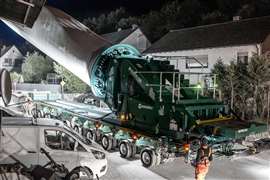Management systems unleash full potential of fleets
02 April 2018
Fleet management technologies enable heavy equipment rental businesses to centralize, automate and maintain often overlooked business processes. This is especially true for those companies that are using multiple systems to manage fleet operations.

Businesses with a proper fleet management system in place are able to centralize operations and incorporate best practices and processes across all departments. These changes lead to more efficient employees, an increase in data accuracy and much more – all of which have the potential to impact profitability.
Let’s review five operational areas that impact efficiency and profitability that can be improved through use of fleet management software.
1. Burden costing
Are you under-applying or over-applying your burden cost?
Fleet management systems give users the option of applying burden to units and jobs. The burden represents the overhead of your company; it can be comprised of management salaries, insurance, utilities, advertising and a whole host of other expenses that keep your business running.
The burden is applied to your units and jobs based on a combination of the following calculations: a percentage of labor or material dollars, a multiple of hours worked or a multiple of hours paid. The basic procedure will require you to forecast your overhead expenses and then forecast the base unit or driver (wages, materials or hours). Once you have derived your factor, simply key it into your fleet management system. Now, your profit and loss reports will give you an idea of how different units and jobs contribute to covering your overhead in the hopes of increasing your profits.
The beginning of the year is the perfect time to examine your burden as key factors like tax and insurance rates fluctuate on a calendar year basis. Using fleet management software makes it easy to maintain this information because it is held in a central location. Running reports to determine where your cost should be can be done with a few keystrokes. Burden costs get passed onto your customer, to stay competitive and increase profits, it is important that they are accurately reflected and maintained.
2. Workers’ comp rates
Whether you are a small, medium or large-size company, one of the largest costs of doing business are employee wages. Most states require that you carry workers compensation insurance. Capturing this cost accurately is key to understanding which jobs/units are profitable and which are not. Most workers’ comp rates run on a calendar year basis, so understanding where your business stands in January can help you in job forecasting, budgeting and projecting profits for the upcoming year. Centralized fleet management software makes the updating and maintaining of this crucial information easy for your human resources and administrative staff. If you forget to update your workers’ comp rate, your profit reporting will be off.
3. Revenue by customer
Reviewing revenue by customer from the previous year can prove extremely useful in examining your operation. By using the reporting capabilities within fleet management software, you can
easily see how your customer mix changes from year to year. You can tackle critical planning questions such as:
- Do we need to diversify our revenue base?
- Would our company benefit from adding personnel with specialized knowledge or skills based on where the bulk of our revenue is sourced from?
- By using business intelligence provided by fleet management software, you can direct time and money efficiently and earn a competitive advantage to drive profits.

4. Sales and Use tax rates
Sales and Use taxes are the “elephant in the room” that nobody wants to talk about. However, understanding and applying the correct sales tax rates is necessary for accurate invoicing and to avoid potential liabilities. Accurate invoicing is not only billing for the proper amount of labor, equipment and freight but sales tax as well. Most heavy equipment and crane rental companies will be applying destination-based taxes (where businesses tax customers based on the location where equipment is being sent) as opposed to origin-based tax laws (where customers are taxed based on the location of the business).
This can get very complicated for companies that do business in multiple states. Many states, for example have rates that differ from county to county. It is important to understand and apply these rates accurately. Although making sure the changes to state sales tax rates is initially time consuming and complex, a central fleet management system makes maintaining them more manageable.
5. Monitoring certifications
For fleet managers in the heavy equipment rental industry, having the right people on the right job is critical. Your staff must maintain a variety of certifications that allow them to operate different types of equipment, or even to operate at certain jobsites. This varies from state to state and company to company but having an operations system that tracks and stores employee information in one place makes the safety director’s or dispatcher’s job much easier. Reports can easily be run to determine which employees have to renew their certifications and when. Fleet management systems also provide a form of constraint when scheduling by validating that employees have proper certifications when assigning personnel to jobs. Consistently reviewing your employees’ availability vis-à-vis their certifications ensures you are the reliable service provider you strive to be.
Leveraging fleet management software leads to the most efficient way of conducting business and ensures there is always an opportunity to take a top-down look at important operational concerns that impact profits.
Start the process of investing in a fleet management system now and unleash the full potential of your fleet.
STAY CONNECTED


Receive the information you need when you need it through our world-leading magazines, newsletters and daily briefings.
CONNECT WITH THE TEAM










